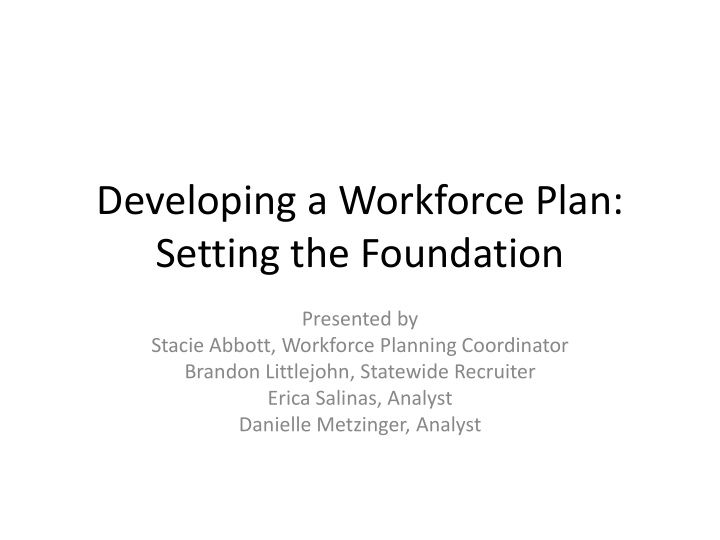



Developing a Workforce Plan: Setting the Foundation Presented by Stacie Abbott, Workforce Planning Coordinator Brandon Littlejohn, Statewide Recruiter Erica Salinas, Analyst Danielle Metzinger, Analyst
Objectives • Identify Recruitment, Retention, Succession Planning Strategies • Develop the workforce plan • Implement and evaluate the plan • Workforce Plan examples
3 Risk Areas of Workforce Planning 1. Recruitment 2. Retention 3. Succession Planning Develop strategies that mitigate risks based on gap analysis findings
Gap Analysis Methodology
Targeting Strategies • Align with strategic missions/goals • Utilize data to expose opportunities • Prioritize by key classifications and competencies
Recruitment Strategies Utilize Data: high competency gaps, high vacancy rates • Tailor recruitment strategies • Hiring processes – Exams – Application screening – Behavioral interviewing
Contact the Statewide Recruiter Brandon Littlejohn Statewide Recruiter (916) 324-9379 Brandon.LittleJohn@calhr.ca.gov
Retention Strategies Utilize data: high turnover, high transfer patterns • Employee satisfaction survey • Input from division/program management • Retention Strategy Survey (when available)
Examples of Retention Strategies • Employee recognition program • Knowledge transfer opportunities – New Employee Onboarding
New Employee Orientation v. Onboarding • Orientation and onboarding are different processes • Onboarding represents a form of institutional knowledge transfer while orientation is simply transfers explicit knowledge
New Employee Orientation • Focus on transactional processes (ie: computer set-up, acquiring name badge) • Less than 1 week • Executed by designated division/program • Addresses benefits and provides departmental overview • Employee participation is passive • Establishes new hires into department
Onboarding • Assimilation process focused on tools and knowledge to be successful st year • Includes 1 • Integrates multiple functions/individuals • Addresses all new employee needs over long- term period • Employee participation is active • Aims to increase likelihood of retention and productivity
Onboarding at the Department of Technology Download the New Employee Onboarding Plan from the Department of Technology
Succession Planning Purpose: Mitigate separation risks Process: Recognize, develop, and retain leadership talent especially in critical classifications Product: Practical strategies to develop a pipeline of future leaders
Succession Planning Strategies • Voluntary nomination to leadership development program • Knowledge transfer opportunities
Knowledge Transfer Goals • Mitigate retention and separation risks • Develop current workforce • Ensure important knowledge is not lost
Types of Knowledge • Explicit = concrete – Procedural knowledge • Tacit = experiential – Personal characteristics – Development of cooperative partnerships • Both – Institutional knowledge
Examples of Explicit Knowledge Transfer Strategies • Individual professional development • Desk manuals • Online options • Orientation
Examples of Tacit Knowledge Transfer Strategies • Coaching • Career development
Examples of Institutional Knowledge Transfer Strategies • Group activities • Cross-training • Mentorship • Job shadowing • Onboarding
Knowledge Transfer at Caltrans Download the Knowledge Transfer Guidebook from Caltrans
Benefits of Mentorship • Builds bench strength • Provides global perspective • Strengthens diversity • Engages staff in departments mission • Supports succession planning • Fosters trust, respect and openness
Mentorship Best Practices • Voluntary participation • Identify development goals • Respect confidentiality in sessions • Respect each other’s time
Informal Mentorship at CalPERS • Download the Informal Mentoring Toolkit for Managers and Supervisors from CalPERS • Download the Informal Mentoring Toolkit for Executives and Senior Leaders from CalPERS
Workforce Plan Template Download the Workforce Plan Template
Establish Metrics • S pecific • M easureable • A chievable • R ealistic • T ime-Bound
Communicate the Plan • Plan to communicate to stakeholders about progress in a relevant and timely manner – Who needs to know what? How often? In what way? – Refer to Workforce Plan Template Appendix D (page 10) • Keep department engaged – Share workforce and succession planning articles – Advertise professional development opportunities – Maintain employee recognition program
Implement the Plan • Follow the Action Plan Benchmarks and Communication Plan you have developed for each initiative
Evaluate the Workforce Plan Download the Workforce Planning Evaluation Assessment Tool
Recommend
More recommend